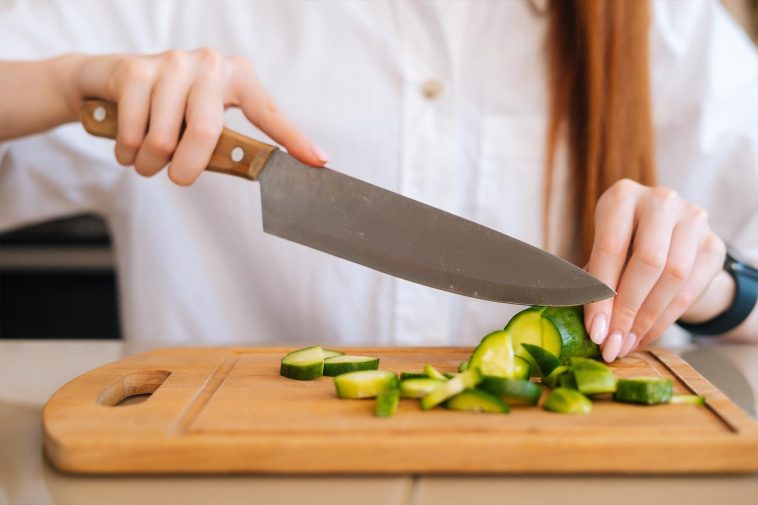A chef’s knife is not just a tool; it’s an extension of the chef’s hand. In the culinary world, the importance of a chef’s knife cannot be overstated. It’s a versatile workhorse, capable of chopping, slicing, dicing, and mincing. This article aims to guide you through the nuances of choosing the perfect chef’s knife, covering types, key features, and maintenance. Whether you’re a professional chef or a home cook, understanding these aspects will help you make an informed decision, ensuring your knife is not only a kitchen staple but a culinary partner.
Types of Chef’s Knives
Chef’s knives come in various styles, each with unique characteristics:
- European Chef’s Knives: Known for their sturdiness and versatility, these knives typically have a curved blade, allowing for a rocking motion during chopping. They are generally heavier and ideal for a range of tasks, from cutting meat to mincing herbs.
- Japanese Chef’s Knives: These knives are famed for their sharpness and precision. With a thinner blade and lighter construction, they are perfect for delicate tasks like slicing fish or vegetables.
- Specialty Knives: Beyond the general-purpose chef’s knives, there are specialty knives like Santoku, Nakiri, and others, each designed for specific tasks. For instance, a Santoku is excellent for slicing, dicing, and mincing, while a Nakiri is ideal for chopping vegetables.
Understanding the differences and uses of these knives will help you choose the one that best fits your cooking style and needs. For an in-depth kitchen knife guide, check out Serious Eats.
Key Features to Consider
When selecting a chef’s knife, several key features need consideration:
- Blade Material and Sharpness: The most common materials are stainless steel and high-carbon steel. Stainless steel is durable and resistant to rust, while high-carbon steel maintains a sharper edge for longer.
- Knife Size and Length: Chef’s knives typically range from 6 to 12 inches. The right size depends on the user’s comfort and the tasks at hand. An 8-inch knife is often a versatile choice for various kitchen tasks.
- Handle Comfort and Grip: The handle should feel comfortable and secure in your hand. Materials vary from wood to plastic to composite, each offering different levels of grip and comfort.
- Balance and Weight: A well-balanced knife feels comfortable and reduces hand fatigue. The weight should be distributed evenly between the blade and the handle.
For more on knife balance and weight, visit America’s Test Kitchen.
Maintenance and Care
Proper maintenance is crucial for the longevity of your chef’s knife:
- Sharpening Techniques: Regular sharpening is essential. You can use a honing rod for daily maintenance and a whetstone for periodic sharpening.
- Cleaning and Storage: Always hand wash your knife and dry it immediately to prevent rust or corrosion. Store it in a knife block, magnetic strip, or sheath to protect the blade.
- Preventing Wear and Tear: Avoid using your chef’s knife on hard surfaces like glass or stone, and don’t use it for tasks like cutting through bones or frozen foods, as this can damage the blade.
By understanding these aspects of chef’s knives, you can choose a knife that not only fits your kitchen needs but also lasts for years, becoming a cherished tool in your culinary adventures.
Personal Preferences and Cooking Style
Choosing the perfect chef’s knife largely depends on personal preferences and cooking style. Consider the following:
- Matching the Knife to Your Cooking Needs: If you frequently chop hard vegetables, a sturdy European knife might suit you. For delicate slicing, a Japanese knife could be ideal. Think about the foods you most often prepare.
- Comfort and Ease of Use: The knife should feel like an extension of your hand. It should be comfortable to hold and not cause strain during use. Test different knives to see which feels most natural in your grip.
Budget and Investment
When investing in a chef’s knife, consider both the price and the quality:
- Price Range and Quality: Chef’s knives are available at various price points. Higher-priced knives often offer better materials and craftsmanship.
- Long-term Value vs. Short-term Savings: An expensive knife can be a long-term investment, offering durability and sustained performance. Cheaper knives might save money upfront but could require more frequent replacements or sharpening.
Top Picks and Recommendations
Here’s an overview of some popular chef’s knives:
- Western-Style Knives: Known for their durability and versatility. They are generally heavier, making them suitable for a variety of kitchen tasks.
- Pros: Robust and versatile.
- Cons: Can be heavy, requiring more effort for delicate tasks.
- Japanese-Style Knives: Renowned for their sharpness and precision. They are lighter and ideal for precise cuts.
- Pros: Extremely sharp and precise.
- Cons: Often more delicate and require careful maintenance.
- Specialty Knives: Like Santoku or Nakiri, designed for specific tasks.
- Pros: Excellent for their intended use.
- Cons: Less versatile than general-purpose chef’s knives.
FAQs
How to Test Knife Sharpness?
- A sharp knife should easily slice through paper or ripe tomatoes without resistance. If it struggles or tears the material, it needs sharpening.
Best Practices for First-Time Buyers?
- Start with a versatile, medium-sized knife. Consider an 8-inch chef’s knife for its versatility. Focus on how the knife feels in your hand and its balance.
Differences in Knife Care for Various Materials?
- Stainless Steel: Resistant to rust and corrosion, easier to maintain.
- High-Carbon Steel: Holds a sharper edge longer but requires more care to prevent rusting.
- Always hand wash and dry your knives, regardless of the material, to maintain their condition.
Choosing the right chef’s knife involves balancing personal preferences, cooking style, budget, and the qualities of the knife itself. By considering these factors, you can select a knife that not only enhances your cooking experience but also serves you well for many years.






Comments
Loading…